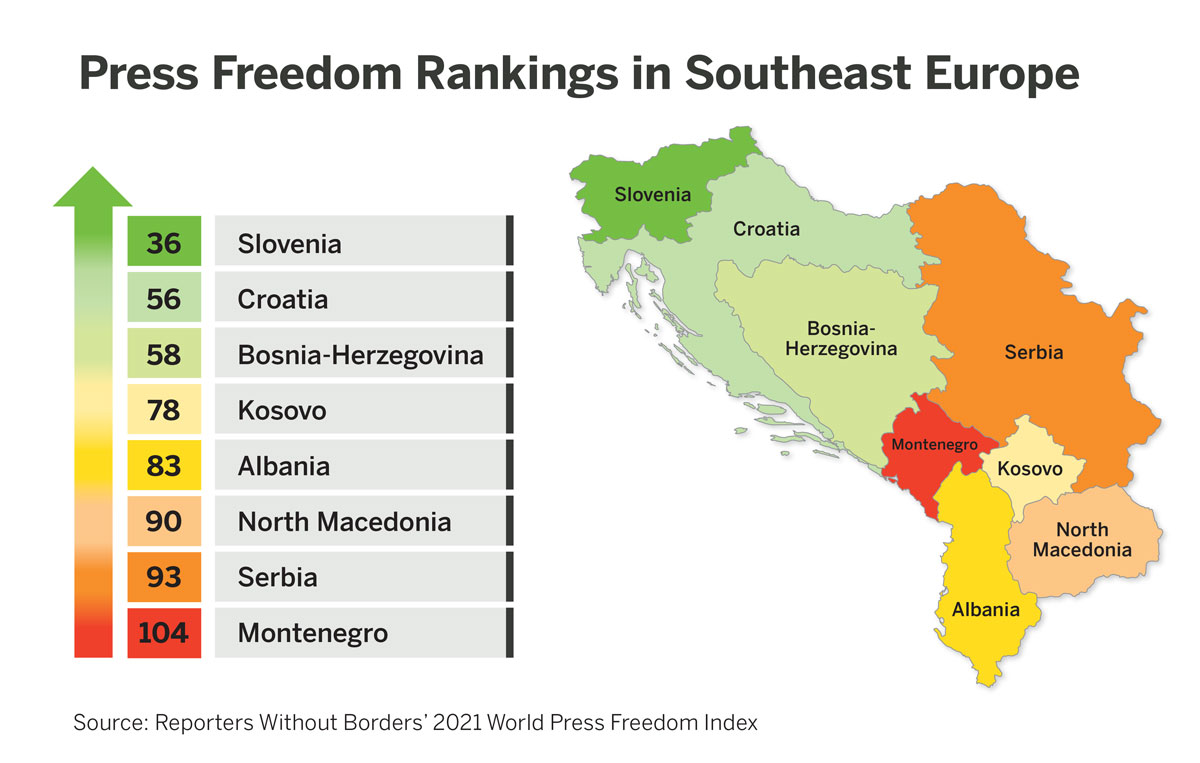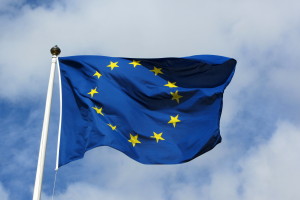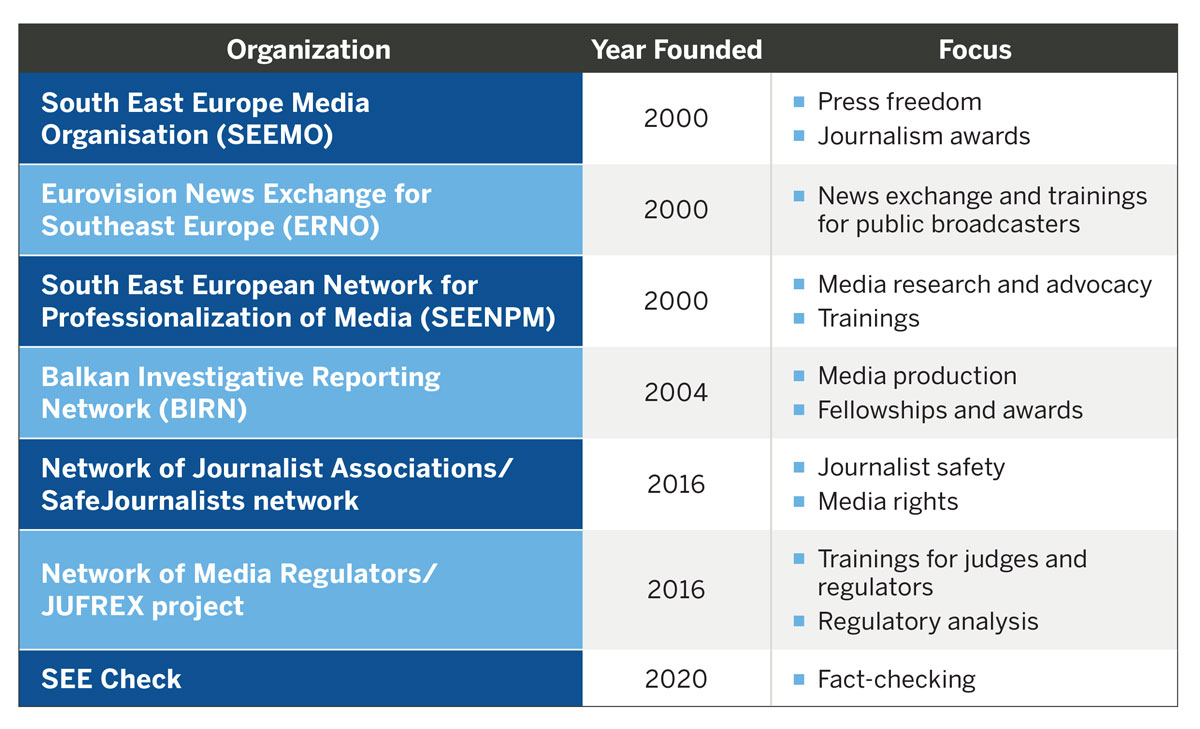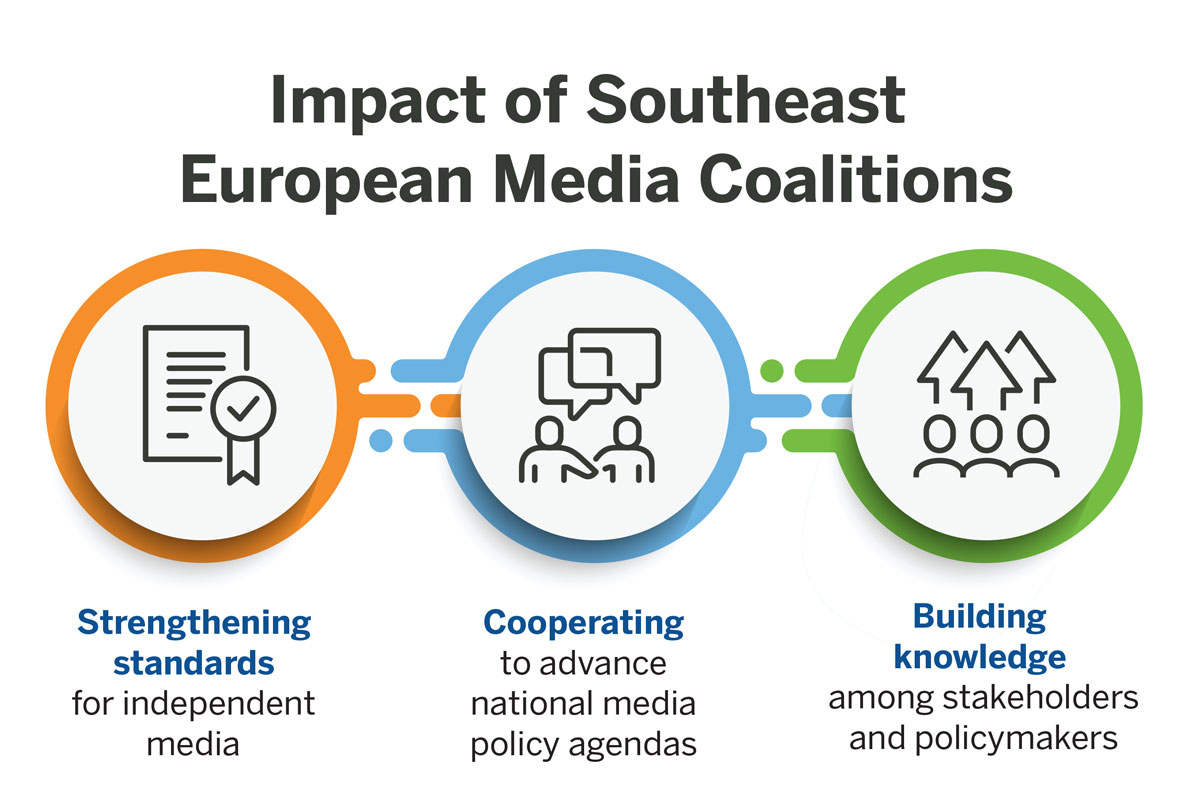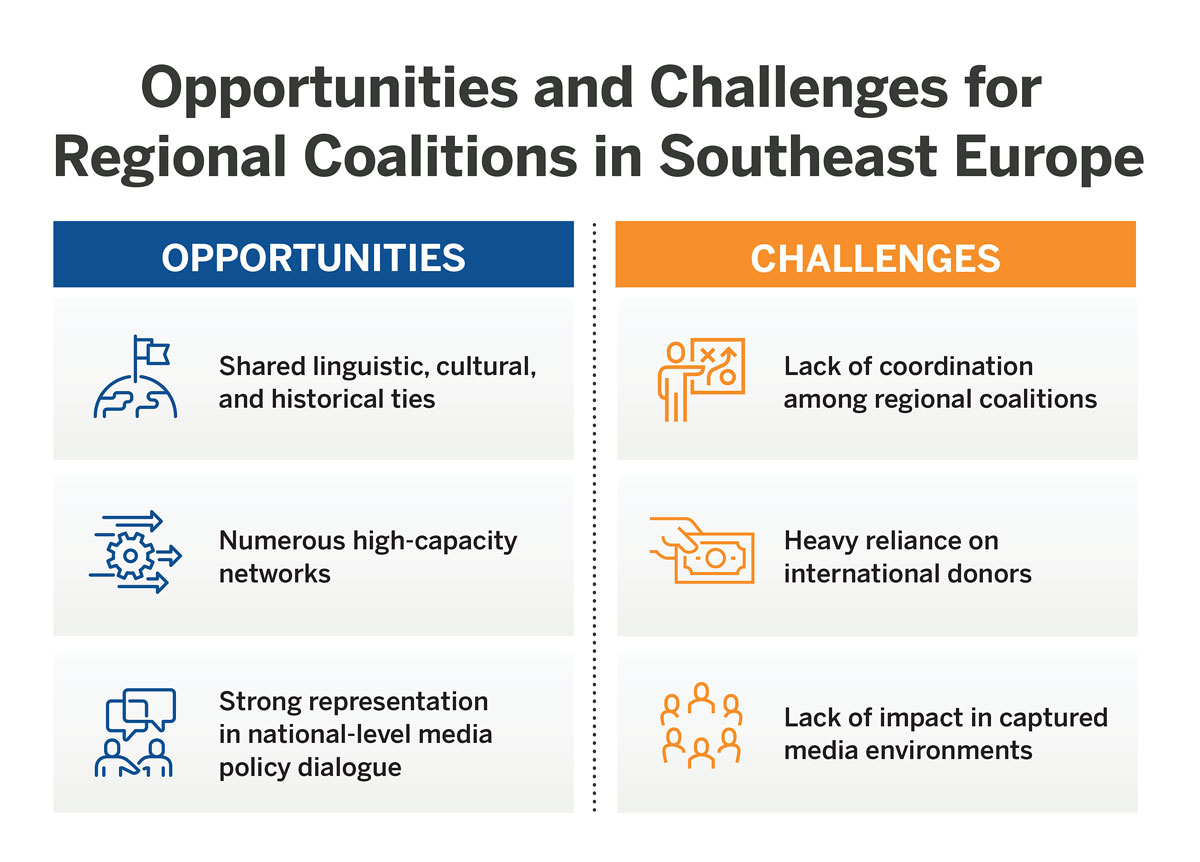Key Findings
Political shifts in Southeast Europe over the past thirty years were followed by dramatic improvements in the media sectors of several countries, including Albania, Bosnia and Herzegovina, Croatia, Kosovo, Montenegro, North Macedonia, Serbia, and Slovenia. Yet, over the past decade, progress has stalled. Independent media in countries across Southeast Europe are under attack and must contend with declining revenue models, rampant disinformation, deepening encroachment of political and economic interests, and sustained harassment.
With challenges come opportunities. Southeast Europe’s strong tradition of regional cooperation for media reform can be leveraged to address the renewed threats independent media face. Countries in the region have shared cultural and trade ties, common media markets, and face similar threats to a free and independent press. They also benefit from numerous existing regional coalitions and networks that have worked for decades to develop shared norms and standards and promote cross-border knowledge sharing and solidarity.
– Southeast Europe’s regional media coalitions, organizations, and networks are a significant force for promoting media freedom, independence, and pluralism.
– Regional coalitions are important drivers of national reform efforts. They need to be equipped to take advantage of new windows of opportunity and tap into the power and influence of the numerous multilateral organizations that serve the region.
– The support of international donors and multilateral institutions is critical to advancing media reform agendas in Southeast Europe. However, more needs to be done to broaden and deepen support, and to tap into the collective capacities and assets of local media organizations and regional media coalitions.
Introduction
Democracy and stability depend on a vibrant and independent media. For the countries of Southeast Europe—which for the purposes of this report include Albania, Bosnia and Herzegovina, Croatia, Kosovo, Montenegro, North Macedonia, Serbia, and Slovenia—goals such as strengthening good governance, building prosperity, and reducing ethnic tensions can come about only in an environment where the media are truly independent, pluralistic, and professional. That means news media that are not only free to report critically on the actions of the powerful, but also able to disseminate a multitude of different voices and perspectives in a way that serves the public interest in a democratic society.
Multistakeholder coalitions and regional and international networks are essential mechanisms that contribute to strengthening the laws, policies, norms, standards, and institutions that promote and protect a vibrant and sustainable independent media sector. Coalitions and regional networks can help media advocates work in a more strategic and coordinated manner on relevant issues, and build the political will needed to sustain progress. Regional networks and coalitions can also drive national reform efforts, especially when they collaborate with other civil society organizations and networks.
The independent news media in Southeast Europe are in peril. Despite initial progress during reform efforts in the early 2000s, movement toward creating a more pluralistic and sustainable media environment has slowed, and in some countries even reversed. Many countries in the region are facing democratic backsliding.1 Major media outlets are captured by political or economic factions, disinformation is rampant, and independent journalists face increasing levels of pressure and harassment.2
Against this grim picture, a number of independent news media in these countries continue to stand in defense of quality journalism, often relying on international support, as limited as it is. Regional coalitions support these efforts through various initiatives, including research, advocacy, training, and other capacity-building projects that help create a stronger enabling environment for independent media. Some incentives for media reform stem from the standards set by the European Union (EU) and its accession requirements.
This report assesses the opportunities and roadblocks to cross-border cooperation for media development and reform in Southeast Europe. It also makes recommendations for the road ahead. Since 2015, CIMA has worked with Deutsche Welle Akademie and other partners to host consultative multistakeholder regional dialogues motivated by one essential question: How can cross-border networks work together most effectively to address the myriad challenges threatening independent journalism? Building on previous work in Latin America (2015), Southeast Asia (2016), sub-Saharan Africa (2017), West Africa (2019), the Middle East and North Africa (2019), and Southern Africa (2021), this report examines the opportunities and roadblocks to coalition-building for media reform in this important European region that, throughout history, has had enormous consequences for peace and stability far beyond its borders.
The Logic of a Regional Approach to Media Development in Southeast Europe
Many countries in Southeast Europe are experiencing progressive democratic backsliding and have political and economic environments that are hostile to quality journalism. There are some notable exceptions, namely Montenegro and North Macedonia, which have made recent gains.3 However, despite improvements, significant challenges to a free and independent press remain. As a result, national approaches are often insufficient to support independent journalism from a growing array of threats. Fortunately, media advocates in the region benefit from numerous regional media coalitions, advocacy groups, trade groups, and news outlets that play a key role in articulating the needs of local media, improving the media sector’s overall capacity for quality journalism, and advocating for better media policies and better protection of journalists. The work of these regional media coalitions is greatly enhanced by the support of international donors, as well as their connections to intergovernmental bodies and regional and global independent media advocacy organizations and forums.
 The argument for a continued and enhanced regional approach to media development in Southeast Europe is a strong one. Though the media environments vary significantly across the eight countries, they share many of the same challenges. Media capture by political and economic interests, weak media markets, and declining advertising revenues exacerbated by the rise of social media platforms threaten the viability of business models for independent media. Deepening democratic backsliding and the rapid spread of disinformation are further restricting the space for independent media and media pluralism. Additionally, many of the countries in Southeast Europe have linguistic,4 cultural, and trade ties, and their media outlets often share audiences and cross-publish news reports. Hence, a worsening in Serbia’s media environment, for example, can have an immediate impact on the information ecosystem in Bosnia and Herzegovina, Montenegro, Kosovo, or North Macedonia.
The argument for a continued and enhanced regional approach to media development in Southeast Europe is a strong one. Though the media environments vary significantly across the eight countries, they share many of the same challenges. Media capture by political and economic interests, weak media markets, and declining advertising revenues exacerbated by the rise of social media platforms threaten the viability of business models for independent media. Deepening democratic backsliding and the rapid spread of disinformation are further restricting the space for independent media and media pluralism. Additionally, many of the countries in Southeast Europe have linguistic,4 cultural, and trade ties, and their media outlets often share audiences and cross-publish news reports. Hence, a worsening in Serbia’s media environment, for example, can have an immediate impact on the information ecosystem in Bosnia and Herzegovina, Montenegro, Kosovo, or North Macedonia.
Regional cooperation helps media reform efforts by enabling knowledge sharing across borders, amplifying local voices in regional and international forums, identifying incentives for media reform, activating diverse human, financial, and legal capacities, and encouraging collective action against threats to media freedom, independence, and sustainability.5 It is also vital in addressing transnational challenges like internet governance and the regional spread of online disinformation.
As in other parts of the world, regional organizations and networks in Southeast Europe can enable cross-border knowledge sharing and collaboration and foster regional and international pressure for media reforms, even in more authoritarian political environments. They also greatly enhance the capacities and voices of the smallest countries whose views might otherwise be ignored in larger forums. Countries such as Montenegro or Kosovo have much to gain from regional conversations about applying democratic norms to media regulation and policy. Southeast Europe’s regional coalitions have significantly impacted media policy in the recent past and, in countries where the political space currently allows, are likely to do so again in the near future.
Background
The political shifts in the past thirty years were followed by dramatic changes in the media sector of the eight counties covered in this report. Over the last three decades, international actors have provided critical support for media reforms in the region, including the EU, Council of Europe (COE), Organization for Security and Co-operation in Europe (OSCE), United States State Department and Agency for International Development (USAID), and the United Nations. This support, which was highest in the early 2000s, was important in helping to establish media institutions, transform state broadcasters into independent, public service broadcasters, develop self-regulatory systems in some countries, facilitate collective organizing, and enable the development of private media sectors.6
During the period of reform in the early 2000s, several significant regional media coalitions were established. For example, leading editors-in-chief, media executives, and academics founded the Vienna-based South East Europe Media Organisation (SEEMO) in 2000. Other regionally focused media coalitions started around the same time, including the South East European Network for Professionalization of Media (SEENPM); the Sarajevo-based Eurovision News Exchange for South East Europe; and the Balkan Investigative Reporting Network (BIRN). These coalitions are funded at least in part by international donors, and they are involved in conducting investigative journalism, issuing press freedom alerts, sponsoring journalism awards and events, providing trainings, conducting research and reporting on the media, and setting ethical standards. Their efforts have provided a strong foundation for a regional approach to support media development efforts in Southeast Europe.
By 2010, media in the region had made great strides. National laws and regulations provided many of the formal guarantees of media freedom. Foreign donors provided funding for media outlets and regional coalitions, as well as trainings and exchange programs to promote quality journalism and media business practices.
Yet the momentum stalled over the past decade. In many countries in the region, reform efforts slowed or reversed. Serbia, for instance, fell to 93rd among 180 countries in Reporters Without Borders’ 2021 World Press Freedom Index, 34 places worse than where it stood in 2016.7
Recent backsliding is occurring even in Croatia and Slovenia, the only two EU members in the region. The Croatian Democratic Union, which has ruled Croatia for much of its 30-year existence, has tilted toward illiberal policies, not only threatening independent media, but also exercising tighter control of nonpolitical government agencies and the judiciary.8 In Slovenia, threats to the independence of public service media have become particularly acute since the March 2020 elections won by Prime Minister Janez Jansa’s right-wing Slovenian Democratic Party.9
Media capture by political or economic factions is a growing problem across the region, as is the concentration of media ownership in the hands of a small number of companies. In Serbia, all four national broadcast television stations, including the public broadcaster, are strongly supportive of President Aleksandar Vučić’s Serbian Progressive Party.10 In the print sector, just four Serbian companies control an audience share of 71 percent.11 Even in Albania, long known for its abundance of media outlets, eight owners control as much as 80 percent of the country’s audience.12
There are other challenges as well. Mis- and disinformation and propaganda are endemic. This is prevalent not only on social media, but also in news produced by media outlets affiliated with leading political parties, which include privately-owned mainstream media and even some public service broadcasters. Sensationalist and partisan reports published by Serbian tabloids are carried by news outlets in other parts of the region, notably Montenegro, Kosovo, and Croatia. Numerous media outlets affiliated with foreign governments also disseminate disinformation. For instance, Sputnik Srbija, the Serbian language service of the Russian state-owned broadcaster, is accused of promoting anti-EU and anti-NATO rhetoric, spreading pro-Serbian propaganda, and sowing instability in the region. The spread of misinformation and disinformation in the region is not bound by national borders. While Sputnik Srbija is based in Serbia, Serbian media are followed and quoted in Kosovo, Montenegro, North Macedonia, Croatia, and Bosnia.13
Numerous other attempts have been made by corporate and political actors from outside the region to extend their influence in the media sectors of countries in Southeast Europe. While the region’s media have seen foreign investment by companies including the Amsterdam-based United Group and the Swiss-German conglomerate Axel Springer AG, businesspeople with close links to Hungary’s populist right-wing Fidesz party recently purchased controlling shares in more than a half dozen media outlets in North Macedonia in what appeared to be an effort to influence Macedonian politics.14
 This isn’t the first time that media companies aligned with Hungarian Prime Minister Viktor Orbán have moved into Southeast Europe. In 2017, three Hungarian media firms bought a 45 percent stake in NOVA24TV.si, a Slovenian outlet that serves as a mouthpiece for the country’s conservative Slovenian Democratic Party. More recently, Hungarian businesspeople bought several news outlets in Slovenia and North Macedonia that have ties to Orban’s political allies. These financial relationships are raising concerns that Orbán’s loyalists are replicating a model they piloted at home, where allied business owners own many of Hungary’s media outlets, and propagandistic reporting targets enemies of the Fidesz government.15
This isn’t the first time that media companies aligned with Hungarian Prime Minister Viktor Orbán have moved into Southeast Europe. In 2017, three Hungarian media firms bought a 45 percent stake in NOVA24TV.si, a Slovenian outlet that serves as a mouthpiece for the country’s conservative Slovenian Democratic Party. More recently, Hungarian businesspeople bought several news outlets in Slovenia and North Macedonia that have ties to Orban’s political allies. These financial relationships are raising concerns that Orbán’s loyalists are replicating a model they piloted at home, where allied business owners own many of Hungary’s media outlets, and propagandistic reporting targets enemies of the Fidesz government.15
In addition, media companies in Southeast Europe face many of the economic and sustainability challenges shared by others around the world. Even before the pandemic-induced economic crisis of 2020, available advertising revenues for independent media were shrinking in the face of competition from global internet platforms like Facebook and Google, as well as from international media companies such as Discovery, Inc., and regional players like United Group. In many countries, government advertising and subsidies are a major source of revenue and are often conditioned on editorial support for government policies.
Given these challenges, it is hardly surprising that salaries for journalists remain low, particularly outside of major cities. In North Macedonia, for example, a recent survey found reporters earned an average of 300 euros per month ($367), about 30 percent less than the country’s average income.16 Low salaries are not the only disincentive to working as a journalist. Reporters in the region also face frequent intimidation campaigns and sometimes physical attacks. Recent examples include:
- the detonation of explosives in front of the house of Albanian journalist Elidon Ndreka in October 2020;
- death threats against Bosnian journalist Nikola Vučić in May 2020 following a political tweet; and
- threats to Macedonian journalist Miroslava Byrns in July 2020 following her questioning of the COVID-19 response in that country.17
In addition, the Independent Journalists’ Association of Serbia warned of a dramatic increase in physical attacks on journalists in the country in 2020. These included violence against journalists during the July 2020 protests over the Vučić government’s management of the pandemic, as well as intimidation of and death threats against the journalist Ana Lalić for her critical reporting about COVID-19 care in hospitals.18
In Slovenia, where attacks on the media were relatively infrequent in previous years, online harassment targeting reporters has increased significantly since Prime Minister Jansa’s government took power in March 2020. Jansa adopted Twitter rhetoric similar to that of former US president Donald Trump. As noted by the International Press Institute, this included posting tweets accusing the leftist daily Delo of working for “deep-state tycoons” and labeling its reporting with #FakeNews and #Presstitution hashtags. Shortly after the election, a government Twitter account retweeted a claim that the investigative journalist Blaž Zgaga is an “escaped psychiatric patient.” Zgaga was hounded by death threats.19
Engines of Media Development and Reform
With challenges come opportunities. For Southeast Europe to regain its media reform momentum, advocates need to tap into the work of key international and multilateral institutions and capitalize on regional and national political openings to reignite the development of a pluralistic, free, and independent press.
European Union
One of the main factors driving media reform efforts in the region is the EU’s financial and political support to media reform initiatives and, to an extent, EU accession requirements. The accession process and its conditionality mechanism remain nominally powerful instruments for the promotion of progressive media reforms even in countries with autocratic governments. Of relevance are two chapters of the EU acquis communautaire, the body of EU law that candidate countries are expected to adopt and implement in order to accede: Chapter 10, which covers the regulation of the media marketplace, and Chapter 23, which covers policies related to the judiciary and the fundamental rights of citizens. Since candidate countries can conclude negotiations only after all EU member governments are satisfied with the progress made in each respective chapter, candidates must meet the demands of the most progressive member states.
On the ground, the EU’s influence is felt through the presence of EU delegations and negotiating teams, visits by representatives of the European Commission and European Parliament, and annual EU monitoring of media freedom. The EU also helps fund key media development projects. In the period 2014-2020, the EU provided about 20 million euros ($24.1 million) for media development in the region, including funding for media outlets as well as support for initiatives in the fields of media self-regulation, public service broadcasting, press freedom monitoring, and support for judicial programs.20
Regional and national coalitions for media development increase leverage over their home governments as a result of the EU’s financial support, its accession requirements, and the presence of EU representatives in discussions on media sector development and reform. For instance, in 2018, after a series of negotiations, the Serbian government formed a working group to create a media policy strategy supported by the EU and the OSCE.21 The members of the group included both representatives of public bodies and leaders of the country’s media and journalist associations. The majority of suggestions put forward by these associations were included in the final version of the Strategy for the Development of Public Information System adopted in January 2020.22
However, in practice, the political dialogue over media reform and development as part of the EU accession process is hardly a panacea. At times, EU demands for reform can appear top-down and unrealistic, particularly when EU members such as Bulgaria and Hungary face many media freedom and pluralism challenges and score the same or lower than many of the countries in Southeast Europe according to the 2021 World Press Freedom Index.23 Conversely, EU demands for reform are inconsistent, and the EU itself sometimes overlooks media freedom violations when a candidate country is making progress toward meeting other accession criteria.24 Reforms undertaken with EU support can also be limited to fulfilling formal requirements, such as adopting the measures outlined in a specific action plan for improvement in the EU acquis, and are not necessarily enforced.25 Experts further argue that in areas where there is little specification in terms of what a norm or standard entails, and key issues related to the norm are spread over several chapters, norm diffusion is less effective. Most of the negotiating chapters do not deal with media freedom and independence directly, and there is a lack of detailed benchmarks and deep analysis to guide reform efforts.26 Finally, as the cases of Slovenia and Croatia demonstrate, once countries attain membership in the EU, accession no longer serves as a lever for reform.
Other International Actors
In addition to the EU, other international assistance actors and bilateral and multilateral agencies have supported media to varying degrees in Southeast Europe since the 1990s.27 There are several noteworthy examples of recent initiatives. The United Kingdom’s two-year £9.5 million ($13.5 million) “Supporting Greater Media Independence in the Western Balkans” program commenced in March 2020, with the aim of improving the sustainability of local media organizations. Implemented by a consortium led by the British Council in partnership with Thomson Reuters and BIRN, it provides 48 media outlets with experts, mentoring, and financial support.
Additionally, USAID’s “Balkan Media Assistance Program” provides about $2 million per year for technical assistance and training on media sustainability, increasing audience reach, strengthening digital security, and promoting regional cooperation among media. Implemented by Internews, the program assists more than 90 media outlets, including 10 key partners.
Other multilateral institutions, including the OSCE and the COE, provide important support for organizations and regional coalitions working to improve legal and policy environments for independent media in Southeast Europe.
![]() With offices in each of the countries of the region, the OSCE is an important ally of national and regional media coalitions and press freedom groups. It monitors and supports media in self-regulation, digital broadcasting, access to information, media production, and new technologies. In addition, the Representative on Freedom of the Media, an independent OSCE office, focuses on the promotion of media freedom and seeks to provide early, visible warnings of threats to the press.
With offices in each of the countries of the region, the OSCE is an important ally of national and regional media coalitions and press freedom groups. It monitors and supports media in self-regulation, digital broadcasting, access to information, media production, and new technologies. In addition, the Representative on Freedom of the Media, an independent OSCE office, focuses on the promotion of media freedom and seeks to provide early, visible warnings of threats to the press.
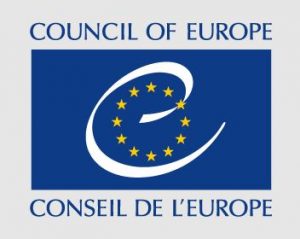 The COE is also involved in supporting media freedom and pluralism in its member states. For instance, in 2015, the COE established a platform to promote the protection of journalism and safety of journalists, better address threats and violence against media professionals, and foster early warning mechanisms and response capacity within the COE.
The COE is also involved in supporting media freedom and pluralism in its member states. For instance, in 2015, the COE established a platform to promote the protection of journalism and safety of journalists, better address threats and violence against media professionals, and foster early warning mechanisms and response capacity within the COE.
While the region benefits from several multilateral organizations that set norms and standards for independent media and provide capacity development and funding for the media sector, they also have overlapping initiatives, poor coordination, and competing agendas.28 Despite these difficulties, these multilateral institutions provide critical support for regional coalitions. They have at times pooled their resources and implemented joint initiatives in the region, such as Reinforcing Judicial Expertise on Freedom of Expression and the Media in South-East Europe (JUFREX), which ended in 2019, and was a joint program between the EU and COE. This program included a regional component that aimed to create opportunities to exchange best practices and find common solutions for similar problems.
This complex multilateral environment, therefore, is both a strength and a challenge for media advocates working in Southeast Europe. To leverage the power of these organizations, it is critical for organizations to collaborate in articulating clear regional demands and strategies for engagement.29
Seizing the Moment: Political Openings
Political openings at the national level, which often occur with a change of government, are an indispensable driver of media reforms. Such openings often provide new opportunities for advocates to push forward a reform agenda.
Though regional media coalitions have little control over when political openings occur in a given country, reform advocates in civil society can have significant impact by allying with reformist politicians and champions within government, and developing clear reform agendas, such that change can be implemented quickly and effectively when openings do occur. This includes building alliances not only with senior political figures or heads of government agencies, but also with mid-level policymakers responsible for implementation and oversight of reforms. It is also important that media advocates integrate their priorities within broader development, good governance, and human rights agendas, and create alliances with civil society in parallel sectors.
Within the eight countries covered by this report, there are currently three such potential openings.
In North Macedonia, the ruling Social Democrats have shown a commitment to media reforms since taking power in 2017. However, some of their proposed policies have stalled. For example, parliament passed legislation meant to improve the independence of the state broadcaster, Macedonian Radio Television, yet the appointment of new members to its governing council has been blocked by a right-wing opposition party.
In Kosovo, the change in government after the country’s February 2021 parliamentary elections may also provide an opening for change. The ruling Vetëvendosje Party has been critical of the public broadcaster and the lack of independence of its governing board. Media experts are hoping that some initial steps toward transparency in public spending will translate into clearer procedures for the appointment of members to both the public service broadcaster and the Independent Media Commission.30
A third opportunity is in Montenegro, where the change in government after the country’s August 2020 parliamentary elections has created a new window of opportunity for media advocates. The new coalition in parliament announced the development of a media strategy and has called for improving policies related to government funding for media,31 as well as strengthening the independence of the nation’s public broadcaster.32 Such steps could serve as an important opening for media reforms in Montenegro. However, some experts fear the new government may shrug off the demands of media, civil society, and international actors and enact nontransparent reforms that may further jeopardize the media environment.33
Regional Collaboration: A Plethora of Assets and Opportunities
Southeast Europe is fertile ground for greater regional collaboration as a mechanism for supporting media sector development and galvanizing political will for reform. Given that the countries in the region are small—Serbia is the most populous with 6.9 million people—each enjoys significant benefits from pooling resources and expertise. Despite a checkerboard of ethnic groups, religions, and languages, the region partly shares many historical, cultural, and linguistic ties.
Sustainable Coalitions
These shared ties help explain the success of a number of regional media coalitions and actors that are, collectively, perhaps the most important force driving change. The seven organizations listed in the table below are by no means the only groups active in this area, but they are among the most visible and significant. These networks include organizations that work in the fields of policy research and analysis, press freedom advocacy, journalism training, fact-checking, and investigative journalism, as well as membership-based groups and self-regulating bodies for public media companies, journalists, and regulators.
Many of these networks have numerous strengths including human capacity from experienced and well-trained staff, and strong organizational structures, strategies, and practices. Several of the region’s networks and coalitions have both a central office and country offices, or members across the region, and have long-standing records of internal knowledge transfer and capacity-building. Others have a looser, more informal structure with no headquarters. The more established groups, such as BIRN, have had a more or less continuous impact on the media environment for more than a decade. Other coalitions might not have continuous activities and impact but can, in their limited periods of operation, improve awareness of media freedom issues and policy dialogue.
Several of Southeast Europe’s regional coalitions are affiliated with international media organizations or journalism associations that further ensure continuity of standards and practices. For example, the Eurovision News Exchange for South East Europe (ERNO), a network of public broadcasters, is part of the European Broadcasting Union. Both SEENPM and SEEMO are members of IFEX, a global freedom of expression group of approximately 100 member organizations.
Regional coalitions in Southeast Europe have also developed fundraising abilities that ensure, to varying extents, a degree of sustainability of their programs. For many regionally focused organizations, funding by international donors was key to their establishment and remains a vital force in enabling their operations. For instance, outside of its donor-funded projects, the SafeJournalists network, which brings together various Southeast European journalist associations and trade unions, issues alerts and reports about attacks on reporters, informing the international community and other journalists of problems in the region. Yet it is the donor-funded database of threats and attacks on the news media that forms the backbone of the network’s research and advocacy capacity. Similarly, the JUFREX program, which supported a coalition of regional media regulators and provided judicial training on freedom of expression issues, would likely not have existed in the absence of donor funding.
Promoting Quality
Regional coalitions have made substantial impacts on the quality of journalism in the region. BIRN, for example, runs a well-regarded fellowship program for journalists that gives them the opportunity to focus on a major long-term project while receiving mentorship by experienced journalists and networking with investigative reporters from other countries. The SEEMO awards, held annually, provide recognition and financial incentive for high-caliber work, while the public broadcaster coalition, ERNO, provides trainings tailored to the needs of public broadcasting staff.
BIRN, which is both a media outlet and media development organization, helps set and maintain professional standards and has a long record of holding the powerful to account. For instance, after the outlet reported on a fortune amassed in Serbia by the son of a fugitive Montenegrin politician, Montenegro renewed a request to have the politician extradited. In 2019 alone, the organization won 19 journalism prizes and its web pages were viewed 60 million times.34
Shining Light
Media coalitions also have a major impact on the visibility of media-related issues. For instance, the SEE Check network of fact-checking platforms has effectively highlighted and tracked the dissemination of disinformation across borders. Its work is cited extensively in local media. Since the start of the COVID-19 pandemic in 2020, page visits to several of SEE Check’s platforms have increased by more than 150 percent.35 An analysis of hate speech in the media, published in 2017, conducted by the regional coalition of regulators, and sponsored by the COE and the EU’s JUFREX program, brought important focus to this sensitive issue for policymakers. A recent exchange program facilitated by members of the SEENPM network among public broadcasting staff in Slovenia and Montenegro led directly to a stipulation in Montenegro’s new media law to create an ombudsman for the public broadcaster. SEENPM has also carried out some pioneering research over the past two decades, shedding light on media development issues and suggesting policy solutions to various issues, including media funding and ownership, media literacy, hate speech, and propaganda.
Making Change
Regional media networks in Southeast Europe also have an impact on media policy and legal reforms. This often begins through their presence in policy dialogues at the national level. In most cases, such networks help build knowledge among policymakers and other stakeholders by putting media freedom and independence on the policy agenda and providing rigorous policy analysis and research. For example, under Slovenia’s previous administration, proposals from the Peace Institute, a Slovene member of the SEENPM network, were included in a 2020 draft media law whose passage was interrupted by the change in government. However, SEENPM was influential in a number of earlier laws in the country, covering issues such as the protection of minors from harmful media content, the regulation of hate speech, and the initiation of programs on ethnic minorities.
Furthermore, representatives from regional media networks are sometimes members of the bodies formed to draft media laws or monitor media freedom issues for governments. For example, the Independent Journalists’ Association of Serbia, a part of the SafeJournalists network, is among the journalist and media associations, police officials, and prosecutors that are part of a working group focused on the protection of journalists. Serbian journalist and media associations, some of which are members of regional coalitions, played a significant role in drafting the Strategy for the Development of Public Information System in 2020, which was pivotal in stopping some of the government’s more illiberal proposals. Success was achieved after all six Serbian media and journalism entities in the working group threatened to withdraw if their input wasn’t included in the draft of the new media strategy.
This move highlights the effectiveness of media coalitions working together to shape policy, a strategy that is more likely to yield results than individual organizations going it alone. A similar joint action in Bosnia and Herzegovina, which included members of civil society and international actors, was also effective in preventing a 2013 proposal that would have undermined the Law on Freedom of Access to Information36 and a 2012 attempt to further politicize the appointment to the supervisory board of the public broadcaster.37
Despite these successes, cooperation among regional organizations, and among regional coalitions and national stakeholders, is far from a regular and systematic practice. As a result, capacity gaps, poor coordination, a lack of consensus on priorities, and duplication of activities have resulted, stymieing their effectiveness. Furthermore, the success remains tainted by the high level of political interference, lack of political will for reforms, and weak mechanisms for implementing good policy solutions.
Static on the Line: Lack of Local Influence
For regionally focused media organizations and networks, the major challenge to reform efforts is that they too often lack influence with country-level policymakers. This is particularly so in countries where the governments are becoming more autocratic, as in Serbia and Slovenia. When policymakers view news media as an instrument for political control rather than a tool for democratization and the free exchange of ideas, reform proposals often fall on deaf ears.
In some countries in the region, the regional coalitions and their local members may, for example, take part in the nomination procedures for members of public broadcasting supervisory boards or media regulatory agencies. Yet this participation does not prevent these boards from being captured by political interests, and the permanent impact of the regional coalitions on the responsiveness of the public sector is minimal. In several of the countries of the region, media organizations and members of regional media coalitions struggle to have their voices heard by policymakers.
This is particularly evident in efforts to reform both state media regulators and public service broadcasters. In much of the region, the independence of both is fragile, if not fully compromised, despite efforts by ERNO and the network of regulators’ JUFREX project. For example, regional coalitions and national reform advocates have been unable to loosen the tight political grip of Serbian President Vučić’s Serbian Progressive Party over that country’s media regulator. Likewise, in Bosnia and Herzegovina, the last appointee as director of the Communications Regulatory Agency was a person with close ties to the ruling party—a move that disappointed reformers and indicated a growing appetite to politicize the body.
Meanwhile, in Slovenia, media reform advocates are fighting efforts by Prime Minister Janez Jansa’s ruling party to divert funding for public broadcasting and diminish the independence of the governing board of the state news agency, the Slovenian Press Agency.38 Since Jansa has accused the public broadcaster’s journalists of spreading “lies” and tweeted that “obviously there are too many of you and you are paid too well,” proposals to strengthen the independence of the broadcaster are most likely unwelcome.39
The Path Ahead
Southeast Europe’s regional media coalitions, organizations, and networks are a significant force for promoting media freedom, independence, and pluralism. Regional coalitions and national media development organizations have played a vital role in previous media reforms in the region and have built substantial assets, including strong organizational capacities and significant expertise and knowledge in media development issues. As such, these organizations are responsible for maintaining crucial drivers of change, including the following:
- Regular forums, conferences, joint research activities, and exchange programs that provide a platform for media actors to come together across countries. These initiatives serve as important spaces for knowledge exchange, dialogue, community building, inspiration, and solidarity.
- Regional resources for early warnings and public alerts about press freedom violations that inform regional and global bodies of threats journalists in the region are facing.
- Resources for promoting shared norms and standards, such as the development of guidelines for journalistic ethics, and awards and fellowships that recognize journalistic excellence.
- Extensive research, policy analyses, advocacy guides, and recommendations for media reforms produced by regional organizations like SEENPM, SEEMO, SafeJournalists, and BIRN, among others.
Despite these numerous assets, independent media in Southeast Europe continue to confront an adversarial political climate. The journalists and media organizations these regional coalitions and networks support are also facing stiff economic headwinds. Together, these two factors have stalled the momentum for media reforms built during the early 2000s, and make the creation and maintenance of a diverse, independent, and viable media environment more difficult.
Several recommendations emerge from this research:
1. When political openings occur, regional coalitions should seize on them to press for reform through joint, simultaneous actions with nation-specific organizations, such as journalist groups and media associations. Regional coalitions should also leverage international actors, such as the EU and European delegations attending regional political meetings,40 to further promote reforms during these periods. In advance of such openings, civil society should be ready with policy analyses, recommendations, and action plans to quickly seize the moment. In the absence of such openings, it should vigorously defend past gains to prevent retrenchment.
2. The engagement of international donors and multilateral organizations and the accession requirements of the EU provide vital support to Southeast Europe’s regional media coalitions and actors. Though several of these coalitions and regional actors are nearly two decades old, the media markets, public sector, and domestic philanthropic institutions are still unable to provide adequate funding to sustain their work. International donors should continue their support and can better assist regional networks by providing strategic, multiyear funding programs. Media sector advocates should also tap into the power and influence of mutlilaterals such as the EU, OSCE, and COE, and develop joint regional agendas and strategies for effective and ongoing engagement with these organizations.
3. The engagement of other international actors, such as press freedom organizations, trade and regulatory associations, investigative reporting groups, and fact-checking platforms, benefits regional efforts at media reform. Given the current challenges, such engagement should be broadened and deepened. In particular, efforts should be made to tap into the collective capacities and assets of these groups, and to coordinate joint actions and initiatives.
Conclusion
The case for renewing and strengthening a regional approach to media reform is a strong one in Southeast Europe. Countries in the region have shared cultural ties, common media freedom issues, and similar media markets in terms of their small size and power. National media development initiatives often lack visibility, making it difficult for them to gain support and traction. While there are many valuable media organizations and networks, journalist associations, and media-focused civil society groups across the region, their capacities are uneven. Finally, countries in Southeast Europe are facing sustained threats to independent media in the face of overall democratic backsliding. These common ties and similar challenges demonstrate the pressing need and strong potential for media advocates in Southeast Europe to strengthen and maintain cross-border cooperation, knowledge sharing, and joint advocacy.
Fortunately, Southeast Europe already has a substantial body of regional media coalitions and networks. The region also benefits from a culture of knowledge sharing and solidarity, evidenced by the many examples of regional conferences and awards, fellowship programs, and cross-border joint programs and initiatives. Though the political and economic climate for independent media is deteriorating in the region, these coalitions, under the support of international bodies and development organizations, such as the EU, OSCE, COE, and the United Nations Educational, Scientific and Cultural Organization can help prevent further erosion of previous gains. When political openings do occur, these coalitions can be influential in helping spur and maintain momentum for reform through the diffusion of democratic standards and norms for governing the media. These regional coalitions are critical for accessing and leveraging international funding to support the process of reform in countries across Southeast Europe and providing assistance for national media advocates to raise their voices and gain traction in regional and global forums.
To discuss opportunities for cross-border collaboration, media stakeholders from across Southeast Europe came together in May–July 2021 for a virtual consultation hosted by the Center for International Media Assistance (CIMA) and Deutsche Welle Akademie. The consultative event identified key challenges in the media sector in the region and built consensus on the best approaches to address them. The consultation brought together approximately 40 media experts, advocates, journalists, and representatives from regulatory bodies and journalists’ associations from eight countries: Albania, Bosnia and Herzegovina, Croatia, Kosovo, Montenegro, North Macedonia, Serbia, and Slovenia. Together, they explored how they could work collectively to address common challenges to independent media and free expression in the region. These challenges include a lack of political will for reform, lax implementation of media policies to safeguard independent journalism, limited media ownership transparency, high degrees of media capture, and the precarious financial situation of news outlets. The recommendations that emerged from this event can be found in a new CIMA publication, Regional Cooperation to Strengthen Independent Media in Southeast Europe: Recommendations from a Consultative Process.
Acknowledgements
This report is based on background research conducted by Sanela Hodžić and Brankica Petković. Jason McLure provided editorial contributions to this report.
Footnotes
- Zselyke Csaky, Nations in Transit 2021: The Antidemocratic Turn (Washington, DC: Freedom House, 2021), https://freedomhouse.org/report/nations-transit/2021/antidemocratic-turn.
- Reporting Democracy, “Secrets and Lies: Transparency and Media Freedom,” in Democracy after Coronavirus (Sarajevo: Balkan Investigative Reporting Network, May 2020), https://balkaninsight.com/2020/05/01/secrets-and-lies-transparency-and-media-freedom/; Marcel Gascón Barberá, Independent Media in Central and Southeast Europe under ‘Assault’ – Report (Sarajevo: Reporting Democracy, Balkan Investigative Reporting Network, January 22, 2020), https://balkaninsight.com/2020/01/22/independent-media-in-central-and-southeast-europe-under-assault-report
- European Western Balkans, “Freedom House: Western Balkans saw both setbacks and progress,” European Western Balkans, March 3, 2021, https://europeanwesternbalkans.com/2021/03/03/freedom-house-western-balkans-saw-both-setbacks-and-progress/.
- Albanian is the official language of Albania and Kosovo and is also spoken by minority populations in several other nations. Bosnian, Serbian, Croatian, and Montenegrin are all a polycentric language, formerly known as Serbo-Croatian, that is understood throughout the region. Though Slovene and Macedonian are more distinct, they are also part of the South Slavic language family.
- Herman Wasserman, The Untapped Potential of Regional Cooperation for Media Reform in Southern Africa (Washington, DC: Center for International Media Assistance, March 2021), https://www.cima.ned.org/publication/the-untapped-potential-of-regional-cooperation-for-media-reform-in-southern-africa/.
- For examples of donor supported projects in the region, see: “Media freedom and development,” OSCE, https://www.osce.org/media-freedom-and-development; and European Commission, “EU Support to Media in The Western Balkans Factsheet,” EU Western Balkan Media Days, September 2019, https://www.euwesternbalkansmediadays.eu/wp-content/uploads/2019/09/Media-days-factsheet.pdf.
- “Serbia,” Reporters Without Borders, accessed May 20, 2021, https://rsf.org/en/serbia.
- Dario Čepo, “Structural Weaknesses and the Role of the Dominant Political Party: Democratic Backsliding in Croatia Since EU Accession,” Southeast European and Black Sea Studies 20, no. 1 (2020).
- “Slovenia,” Reporters Without Borders, accessed May 20, 2021, https://rsf.org/en/slovenia.
- Reporters Without Borders, “Media Ownership Monitor Serbia: National Television Stations in the Service of the Government,” n.d., https://serbia.mom-rsf.org/en/findings/local-media-concentrations-below-the-radar/.
- Reporters Without Borders, “Media Ownership Monitor Serbia: Indicators of Risk to Media Pluralism,” n.d., accessed April 14, 2021, https://serbia.mom-rsf.org/en/findings/inidicators/.
- Reporters Without Borders, “Media Ownership Monitor Albania: Media Concentration,” n.d., accessed April 14, 2021, downloaded May 3, 2021, http://albania.mom-rsf.org/en/findings/media-concentration/.
- Daniel Sunter, “Disinformation in the Western Balkans,” NATO Review, December 21, 2020, https://www.nato.int/docu/review/articles/2020/12/21/disinformation-in-the-western-balkans/index.html?utm_medium=email; Polygraph.info, “Russia’s International Broadcasters: Turning the Serbian Media into a Disinformation Hub,” Polygraph.info, May 4, 2019, https://www.polygraph.info/a/russia-s-international-media-serbian-disinformation-hub/29919939.html.
- Maja Jovanovska, Tamas Bodoky, and Aubrey Belford, “Right-Wing Hungarian Media Moves into the Balkans,” Organized Crime and Corruption Reporting Project, May 9, 2018, https://www.occrp.org/en/spooksandspin/right-wing-hungarian-media-moves-into-the-balkans.
- Jovanovska, Bodoky, and Belford, “Right-Wing Hungarian Media Moves into the Balkans”; Lenart Kucic, Natasa Stojanovska, Zoran Jovanoski, and Anita Vorák, “Hungarian Media Expansion in Balkans Raises Worries but Lacks Impact,” Reporting Democracy, December 4, 2020, https://balkaninsight.com/2020/12/04/hungarian-media-expansion-in-balkans-raises-worries-but-lacks-impact-2/.
- Besim Nebiu, Naser Selmani, Dragan Sekulovski, and Deniz Sulejman, Indicators on the Level of Media Freedom and Journalists’ Safety in Macedonia (Skopje, Macedonia: Association of Journalists of Macedonia, September 2018), www.safejournalists.net/wp-content/uploads/2018/12/Indicators-on-the-level-of-media-freedom-and-journalists%E2%80%99-safety-in-Macedonia.pdf.
- See the alerts on these and other cases on the Council of Europe’s website: https://www.coe.int/en/web/media-freedom/.
- “UNS Upozorava da Raste Broj Napada na Novinare u Srbiji,” Danas, November 2, 2020, https://www.danas.rs/drustvo/uns-upozorava-da-raste-broj-napada-na-novinare-u-srbiji/.
- Jamie Wiseman, “New Administration, Old Agenda: Press Freedom Strained Again in Slovenia under Veteran PM Jansa,” International Press Institute, September 1, 2020, https://ipi.media/new-administration-old-agenda-press-freedom-strained-again-in-slovenia-under-veteran-pm-jansa/.
- European Commission, “EU Support to Media in The Western Balkans Factsheet.”
- “Vlada: Formirana Radna Grup Za Izradu Medisjske Strategije,” Insajder, June 18, 2018, https://insajder.net/sr/sajt/vazno/11587/.
- Insajder, “Usvojena Medijska strategija za period 2020-2025,” Insajder, January 30, 2020, https://insajder.net/sr/sajt/vazno/16777/.
- “2021 World Press Freedom Index,” Reporters Without Borders, accessed June 3, 2021, https://rsf.org/en/ranking/2021#
- Beáta Huszka and Zsolt Körtvélyesi, “Conditional Changes: Europeanization in the Western Balkans and the Example of Media Freedom,” Intersections. East European Journal of Society and Politics 3, no. 2 (2017) https://www.researchgate.net/profile/Beata-Huszka/publication/320642471_Conditional_Changes_Europeanization_in_the_Western_Balkans_and_the_Example_of_Media_Freedom/links/5a5c8c934585154502790dc3/Conditional-Changes-Europeanization-in-the-Western-Balkans-and-the-Example-of-Media-Freedom.pdf
- See for example Marija Stojanović, Srbias Chapter 23 and 24: Authorities care for the form, not the essence of reforms. European Western Balkans, October 4, 2019, https://europeanwesternbalkans.com/2019/10/04/serbias-chapters-23-and-24-authorities-care-for-the-form-not-the-essence-of-reforms/.
- Dragana Bajić and Wouter Zweers, “The EU: Defender of Media Freedom in Serbia?” in Declining Media Freedom and Biased Reporting on Foreign Actors in Serbia: Prospects for an Enhanced EU Approach (Belgrade: European Policy Center, July 2020), https://www.clingendael.org/pub/2020/declining-media-freedom-and-biased-reporting-in-serbia/4-the-eu-defender-of-media-freedom-in-serbia/.
- Kristina Irion and Tarik Jusic, “International Assistance and Media Democratization in the Western Balkans: A Cross-National Comparison,” Global Media Journal 4, no. 2 (2014), https://www.researchgate.net/publication/271012879_International_Assistance_and_Media_Democratization_in_the_Western_Balkans_A_Cross-National_Comparison.
- Ibid.
- See Irion and Jusić, “International Assistance and Media Democratisation in Western Balkans,” 27; See also Aaron Rhodes, Ten Years of Media Support to the Balkans: An Assessment (Amsterdam: Media Task Force of the Stability Pact for South Eastern Europe, 2007).
- Written replies, Jeton Memeti (GAP Institute, Pristina) and Aulona Kadriu (2.0 Kosovo, Pristina), April 12, 2021.
- “Cilj Je da Stvaramo Ambijent u Kojem će Svi Mediji Moći da Rade Profesionalno,” Vijesti, March 12, 2021, https://www.vijesti.me/vijesti/drustvo/520053/krivokapic-cilj-je-da-stvaramo-ambijent-u-kojem-ce-svi-mediji-moci-da-rade-profesionalno.
- Written reply, Olivera Nikolić (Montenegro Media Institute, Podgorica), April 12, 2021.
- Written reply, Milica Bogdanović (Montenegro Media Institute, Podgorica), April 13, 2021.
- See also Balkan Investigative Reporting Network, BIRN Annual Report 2019 (Sarajevo, Bosnia and Herzegovina: Balkan Investigative Reporting Network, August 2020), https://birn.eu.com/wp-content/uploads/2020/08/BIRN_Annual_Report_2019.pdf.
- Written reply, Tijana Cvjetićanin (Raskrinkavanje.ba, Sarajevo), April 13, 2021.
- Nermina Voloder, “Novi nacrt predlaže restriktivniji Zakon o slobodi pristupa informacijama,” Mediacentar Sarajevo, December 6, 2016, https://www.media.ba/bs/mediametar/novi-nacrt-predlaze-restriktivniji-zakon-o-slobodi-pristupa-informacijama-bih.
- Sanela Hodžić, “Flash Report BiH: The Credibility and Competence of PSB Boards Is Questioned,” SEE Media Observatory, July 31, 2013, https://mediaobservatory.net/radar/flash-report-bosnia-and-herzegovina.
- Marja Novak, “Slovenia’s Public Media under Pressure,” VOA News, January 16, 2021, https://www.voanews.com/press-freedom/slovenias-public-media-under-pressure.
- “OSCE Media Freedom Representative Urges Public Officials in Slovenia to Refrain from Pressure on Independence of Public Broadcaster,” Organization for Security and Co-operation in Europe, March 27, 2020, https://www.osce.org/representative-on-freedom-of-media/449287.
- Examples of such events include the Bled Strategic Forum held in Slovenia, conferences and summits organized by The Berlin Process, and the Brdo-Brijuni Process meetings.

